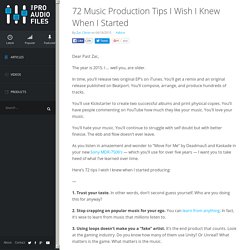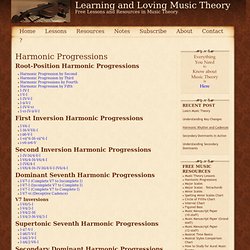

Interactive Circle of Fifths. Scales and emotions. See also a post about making chords from scales.

So maybe you want to write a song or an instrumental in a particular mood or style, and you’re feeling overwhelmed by all the scales. Here’s a handy guide to the commonly used scales in Western pop, rock, jazz, blues and so on. Click each image to play the scale right in your browser with the aQWERTYon. These scales have a major third (E in the key of C), which makes them feel happy or bright. Major scale Happy; can be majestic or sentimental when slow. Mixolydian mode Bluesy, rock; can also be exotic/modal. Lydian mode Ethereal, dreamy, futuristic. Lydian dominant mode Also known as the overtone scale or acoustic scale, because it is close to the first seven pitches in the natural overtone series. Phrygian dominant mode Exotic, Middle Eastern, Jewish.
Harmonic major scale. Song Theme Ideas For The Motivated Songwriter. In addition to having a natural flair for writing, becoming a good songwriter takes time, patience and knowledge.

It also means understanding people and what’s happening in the world, in order to use songwriting themes that listeners will find appealing. Regardless of the genre, there are some song themes that can always be explored for new song ideas, and being aware of these automatically solves part of the puzzle of writing. So, what are some of the top song themes than can motivate you to write? Well, according to a recent study conducted by researchers at the North Carolina State University and published in the Journal of Advertising Research, there are 12 main themes. Chord Calculator. Schillinger System. The Schillinger System of Musical Composition, named after Joseph Schillinger, is a method of musical composition based on mathematical processes.

It comprises theories of rhythm, harmony, melody, counterpoint, form, and semantics (emotional meaning, as in movie music). It offers a systematic and non-genre specific approach to music analysis and composition, a descriptive rather than prescriptive grammar of music. The Schillinger System might have served as a road map for many later developments in music theory and composition. Instead, it languished in relative obscurity. Schillinger's career[edit] Schillinger was a professor at The New School in New York City and taught such celebrated musicians as George Gershwin, Glenn Miller, Benny Goodman, and a host of Hollywood and Broadway composers.
In New York, Schillinger flourished, becoming famous as the advisor to many of America's leading popular musicians and concert music composers. After Schillinger[edit] Beyond style[edit] Musical Form. There are several ways to approach a composition.

Start with overall planning then start sketching. Sketch first then develop an overall plan that fits your ideas. Note: Overall Planning is always in the equation. Sketching without thought of structure leads to aimless stream-of-conscious lack of cohesion. On Thinking about Structure: Today's composer can use traditional formal templates and modern techniques at the same time. Study Voice with Berklee Online. Coursera. The Sacred Geometry Of Music. The Sacred Geometry Of Music by Andrew Lorimer Music uses the laws of vibration to manifest aurally what exists at the center of everything.

Into our reality springs a non-visual harmonic law that is universal. The notes and intervals of music speak directly to the chakra centers and causes them to vibrate in harmony to the vibration of a string or vocal chords, speakers moving through the air, or the sound of someone’s lips making a farting noise through a metal tube. Music uses the laws of physics and mathematics to bring out an emotional response in the listener. 72 Music Production Tips I Wish I Knew When I Started. Dear Past Zac, The year is 2015.

I … well you, are older. In time, you’ll release two original EP’s on iTunes. You’ll get a remix and an original release published on Beatport. You’ll compose, arrange, and produce hundreds of tracks. You’ll use Kickstarter to create two successful albums and print physical copies. You’ll hate your music. As you listen in amazement and wonder to “Move For Me” by Deadmau5 and Kaskade in your new Sony MDR-7506’s — which you’ll use for over five years — I want you to take heed of what I’ve learned over time.
Here’s 72 tips I wish I knew when I started producing: Music. Music Composition. Musician Resources. HipHop/Rap. Percussion. Tutoriales. Lecciones. Teoría - Teoría de la Música Web. Free Guitar Lessons. Ejercicios de entrenamiento auditivo (I) List of chord progressions. Learning and Loving Music Theory.
Kelvin, You actually caught a mistake on the roman numerals!

Thanks, I’ll have to fix that. The first and last chords of the progression are not 7th chords. Somehow I inadvertently typed “I7″ on the first chord of all the major keys. (Notice that I didn’t do that for the minor keys.) Know Every Note on the Guitar in 9 Days. Knowing every note on the guitar is a challenge unique to the instrument.

A saxophone has only one way to finger each note, while a guitar usually has a few different strings and four fingers to choose from. String a few notes together and the permutations of how to play them will wreck your brain. Pianists have a similar problem with ten available digits, but you can memorize the notes on a keyboard in a matter of minutes; the same pattern of white and black keys repeats every octave.
The challenge with navigating the guitar fretboard is its two-dimensional layout. It’s a matrix, while nearly every other instrument has a linear path of notes from the bottom to the top of its range. Free Musical Scales, each in every key, guitar tabs, sheet music, piano images. Chord Calculator. Music Notation Training. Music Theory.
Piano.